
When Francis and Vanessa of Gustus Vitae Condiments first sent me samples of their amazing spices and salts, I didn’t know which one I wanted to try first. I decided on the red wine sea salt as it sounded so original as well as ingenious (sea salt and red wine being two of my favorite flavors).
I’ve often had red wine risottos and liked them but found them a little overpowering especially paired with an actual glass of red wine so the idea of being able to sprinkle some over the top of a classic saffron risotto seemed like the perfect solution. I’m going to try Taste of the Southwest on some skirt steak next!


Risotto alla Milanese with Asparagus and Red Wine Sea Salt
Serves 6
Ingredients
1 bunch of fresh asparagus, ends discarded (slice into ½“ diagonal slices and steam or boil for about 3 minutes until tender)
4 cups of homemade chicken broth, or for vegetarians use vegetable broth (heat in a saucepan on low, ladling from there)
1 medium yellow onion, finely chopped
4 tablespoons of butter, divided in two
2 tablespoons of extra virgin olive oil
2 cups of risotto rice (I like to use Carnaroli but Arborio is often easier to find)
1 teaspoon of powdered Saffron
2/3 cup of freshly grated parmesan cheese
Red Wine Sea Salt to taste
Method
1. In a dutch oven or heavy saucepan, add 2 tablespoons of butter, olive oil and onions. Sweat until translucent – about 5 minutes.
2. Add the rice and cook on medium-high for 2 minutes. Stir continuously so the rice is coated with the fat and onions.
3. Lower the heat and slowly begin to add the stock; one ladle at a time.
4. Stir continuously and only add another ladle of stock once last ladle is absorbed.
5. After about 15 minutes, add the saffron and stir until the entire risotto turns a bright yellow. (If you run out of broth, you can add hot water)
6. Turn the heat off just before you think the risotto is ready (about 20 minutes after you’ve added the rice) – rice should still have a slight bite to it.
8. Stir in the asparagus, the rest of the butter and the parmesan cheese and cover for a few minutes to let everything blend together.
9. Serve in warmed bowls and sprinkle a little red wine sea salt and extra grated parmesan on top for a pop of flavor.








